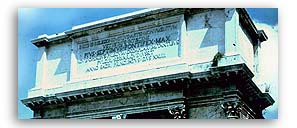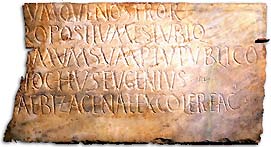 |
|
Writing Writing was a useful tool for the ancient Romans - the written word could communicate ideas to the people of Rome and to Roman subjects throughout the Empire. Only a fraction of the huge number of texts written by the Romans have survived. |
| These texts are found on scrolls as well as on objects as large as buildings or as small as coins. All are valuable, however, for they don't only serve as ways that the Romans communicated with each other; these texts also let the ancient Romans speak to us! |
 |
This is a detail of the Arch of Titus in Rome. |
| The Latin Alphabet
We don't have any examples of writing from the Italian peninsula before the Greeks set up colonies there in the 8th century BC. The Greek alphabet was adopted by the Etruscans and spread throughout peninsula. Also, people living near the Greek colonies in the south may have borrowed the alphabet directly from the Greeks. The Latin alphabet that developed gradually was adopted from the Greek and spread throughout the Roman Empire - to northern and western Europe. We still use it today! |
| Learning to Read and Write
Most people in Rome didn't go to school and didn't learn to read and write. Children from wealthy families, however, began school at about age 6 or 7. Students learned to write on boards spread with wax They scratched letters in the wax with a pointed stick (called a stylus) and then rubbed them out with the flat end of the stick. What do we use in the classroom that lets us write and erase easily, especially your teacher? |
| The Tools of Writing
The Romans used a variety of tools for writing. Everyday writing could be done on wax tablets or thin leaves of wood. Documents, like legal contracts, were usually written in pen and ink on papyrus. Books were also written in pen and ink on papyrus or sometimes on parchment. Inscriptions were sometimes carved in stone on buildings and other monuments, like triumphal arches. |
 |
| This piece is a fragment of a Roman inscription done in marble. |
 |
 |
 |
 |
 |
 |
 |
© Michael C. Carlos Museum of Emory University,
Memorial Art Gallery of the University of Rochester and Dallas Museum of Art
For more information please contact odyssey@emory.edu.
Last Update: